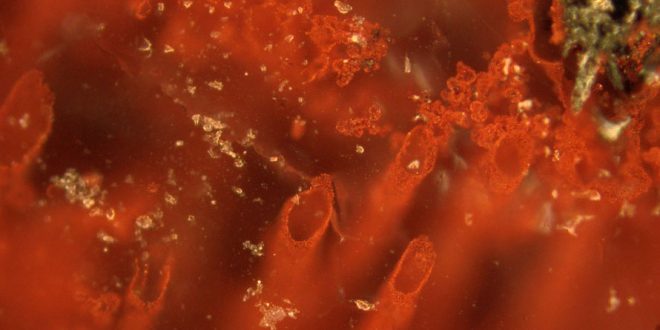A team of scientists has announced the discovery of 3.77 billion-year-old rocks that contain the tiny fossilized remnants of fossilized bacteria.
Tiny filaments and tubes formed by bacteria that lived on iron were found encased in quartz layers in the Nuvvuagittuq Supracrustal Belt (NSB), Quebec, Canada.
The NSB contains some of the oldest sedimentary rocks known on Earth which likely formed part of an iron-rich deep-sea hydrothermal vent system that provided a habitat for Earth’s first life forms between 3,770 and 4,300 million years ago.
“Our discovery supports the idea that life emerged from hot, seafloor vents shortly after planet Earth formed. This speedy appearance of life on Earth fits with other evidence of recently discovered 3,700 million year old sedimentary mounds that were shaped by microorganisms,” explained first author, PhD student Matthew Dodd (UCL Earth Sciences and the London Centre for Nanotechnology).
Published today in Nature and funded by UCL, NASA, Carnegie of Canada and the UK Engineering and Physical Sciences Research Council, the study describes the discovery and the detailed analysis of the remains undertaken by the team from UCL, the Geological Survey of Norway, US Geological Survey, the University of Western Australia, the University of Ottawa and the University of Leeds.
Prior to this discovery, the oldest microfossils reported were found in Western Australia and dated at 3,460 million years old but some scientists think they might be non-biological artefacts in the rocks. It was therefore a priority for the UCL-led team to determine whether the remains from Canada had biological origins.
The researchers systematically looked at the ways the tubes and filaments, made of haematite – a form of iron oxide or ‘rust’ – could have been made through non-biological methods such as temperature and pressure changes in the rock during burial of the sediments, but found all of the possibilities unlikely.
The haematite structures have the same characteristic branching of iron-oxidising bacteria found near other hydrothermal vents today and were found alongside graphite and minerals like apatite and carbonate which are found in biological matter including bones and teeth and are frequently associated with fossils.
They also found that the mineralised fossils are associated with spheroidal structures that usually contain fossils in younger rocks, suggesting that the haematite most likely formed when bacteria that oxidised iron for energy were fossilised in the rock.
“We found the filaments and tubes inside centimetre-sized structures called concretions or nodules, as well as other tiny spheroidal structures, called rosettes and granules, all of which we think are the products of putrefaction. They are mineralogically identical to those in younger rocks from Norway, the Great Lakes area of North America and Western Australia,” explained study lead, Dr Dominic Papineau (UCL Earth Sciences and the London Centre for Nanotechnology).
“The structures are composed of the minerals expected to form from putrefaction, and have been well documented throughout the geological record, from the beginning until today. The fact we unearthed them from one of the oldest known rock formations, suggests we’ve found direct evidence of one of Earth’s oldest life forms. This discovery helps us piece together the history of our planet and the remarkable life on it, and will help to identify traces of life elsewhere in the universe.”
Matthew Dodd concluded, “These discoveries demonstrate life developed on Earth at a time when Mars and Earth had liquid water at their surfaces, posing exciting questions for extra-terrestrial life. Therefore, we expect to find evidence for past life on Mars 4,000 million years ago, or if not, Earth may have been a special exception.”
Agencies/Canadajournal
 Canada Journal – News of the World Articles and videos to bring you the biggest Canadian news stories from across the country every day
Canada Journal – News of the World Articles and videos to bring you the biggest Canadian news stories from across the country every day



